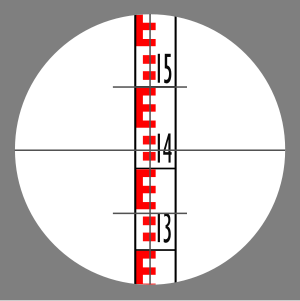Stadia mark
Stadia marks, also called stadia lines or stadia hairs, are crosshairs on the reticle of a theodolite or other surveying instrument that allow stadiametric rangefinding.
Etymology
The term stadia mark derives from the obsolete unit of distance, the stadia. There were several different stadia defined such as the Greek stadia and Egyptian stadia.
Usage

A typical surveyor's instrument reticle has two pairs of stadia marks. One pair are on the horizontal centreline and the other on the vertical cross hair. Each functions in the same manner and are placed for measuring on either axis.
The stadia marks are set a specific distance apart. The distance is chosen so that there is a fixed, integer ratio between the distance observed between the marks and the distance from the telescope to the measuring device observed. This is known as the stadia constant or stadia interval factor. For example, a typical stadia mark pair are set so that the ratio is 100. If one observes a stadia rod, rule or levelling rod with the telescope and sees that the rod spans 0.5m between the marks (the stadia interval), then the distance from the instrument to the rod is:
- 0.5m x 100 = 50 m.
In the adjacent image, the upper stadia mark is at 1.5 m and the lower at 1.345 m. The difference is 0.155 m. Thus the distance from the instrument to the levelling rod is:
- 0.155 x 100 = 15.5 m.
See also
References
- Raymond Davis, Francis Foote, Joe Kelly, Surveying, Theory and Practice, McGraw-Hill Book Company, 1966 LC 64-66263